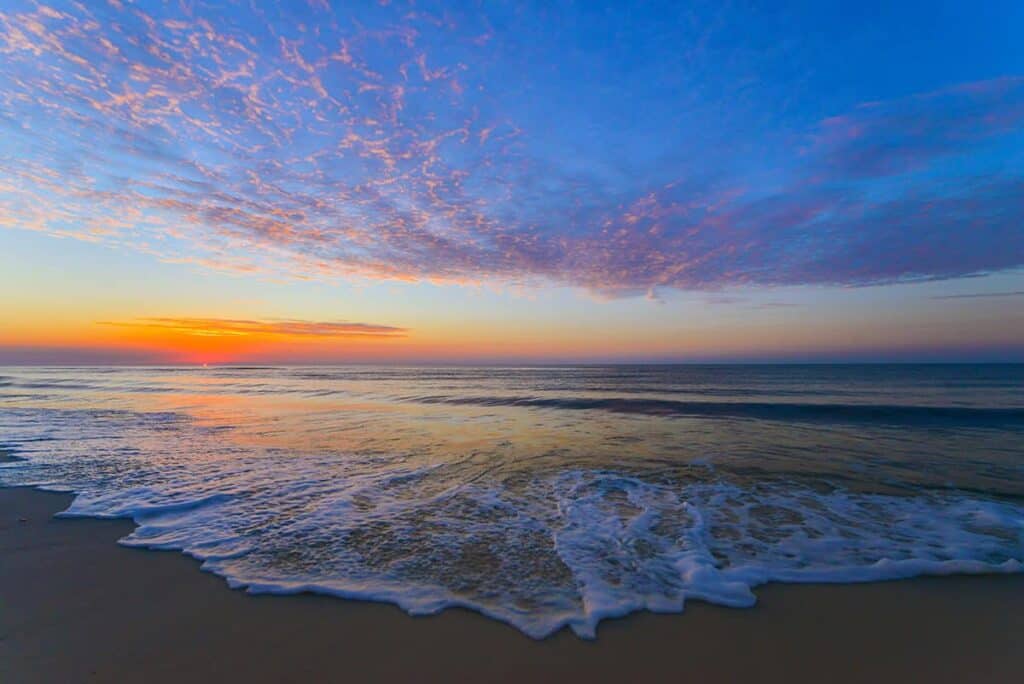It is one of those treasured places no one talks about. Treasured Fort Frederica is a little known national monument on the Georgia coastal island of St Simon. A true hidden gem, these precious archaeological remnants represent what at one time had been a bustling fortress built by General James Oglethorpe. The British occupied it from 1736 to 1748. Many of the townsfolk expected to find their fortunes in the new land. Fort Frederica National Monument pays homage to their efforts.
This post may contain affiliate links, meaning if you purchase something through one of these links, we may earn a small commission at no extra cost to you! Read the full disclosure policy here.

Fort Frederica was a British fort on St. Simons Island, Georgia, built in 1736 by James Oglethorpe to protect the southern boundary of the colony of Georgia from Spanish invasion. The fort played a significant role in the conflicts between Britain and Spain in the region, including the Battle of Gully Hole Creek in 1742. Abandoned after the war, the fort fell into ruin. Currently, the site is a National Monument managed by the National Park Service, which offers tours and educational activities.

Table of Contents
Where is Fort Frederica? How Do I Get There?
From Brunswick GA: Exit 29 off I-95 onto US-17 East. Head east 9.2-miles crossing the Sidney Lanier Bridge (Glynn Ave) turn left at the FJ Torras Causeway. After crossing the FJ Torras Causeway (3.9-miles), stay in the left lane. Follow left lane Kings Way to traffic light. Go straight at the light. Follow Sea Island Road 2.7-miles to Frederica Road. Turn left at traffic light onto Frederica Road. Follow Frederica 2.3-miles to the roundabout. Take the second exit of the roundabout (still on Frederica). Go approximately 1 mile. Turn left onto park entrance road. Across from Wesley United Methodist Church.
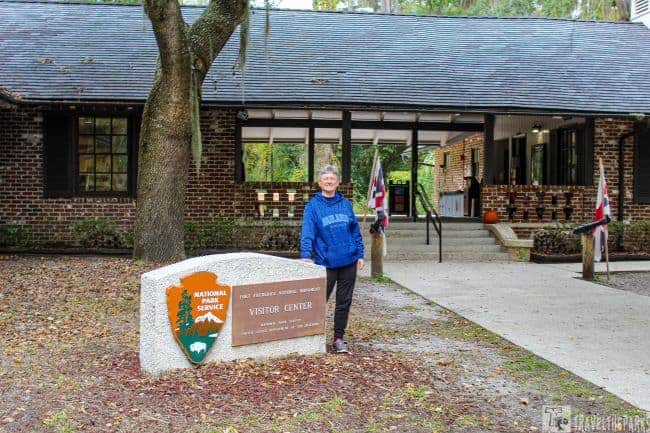
Know Before You Go: Fort Frederica National Monument
Before stepping into the colonial past of Georgia’s coast, here’s everything you need to know to make the most of your visit to Fort Frederica National Monument, one of the quiet treasures of St. Simons Island.
- Location: Fort Frederica is on St. Simons Island, part of Georgia’s Golden Isles. It’s a short drive from Brunswick and easily accessible via the F.J. Torras Causeway.
- Hours of Operation: The visitor’s center and park are open from 9 am to 5 pm Sunday through Saturday except on Thanksgiving Day, Christmas Day, and New Year’s Day.
- Entrance Fees: Best of all, the park is no admission fee. That’s right, it is a free park. No fees. Donations are welcome and help support preservation efforts.
- Free parking is available on-site. Space is limited for large RVs, but smaller Class B/C motorhomes may fit in regular spots during non-peak hours.
- Pets: Leashed pets are welcome on the grounds, but not inside buildings. This is a great stop for traveling with dogs—lots of open green space!
- What to Bring: A camera or phone for photos of the oak-lined paths, tabby ruins, and scenic river views. Comfortable walking shoes for exploring the large open grounds. A picnic lunch—there are benches and shaded areas perfect for relaxing.
Best Things to Do at Fort Frederica National Monument
Don’t let its quiet reputation fool you—Fort Frederica is packed with history, nature, and charm. Here are the best things to do when visiting this hidden gem on St. Simons Island:
- Explore the Historic Ruins: Walk among the tabby concrete foundations of colonial homes, the original military barracks, and the fort’s remains. Interpretive signs help bring the 1700s settlement to life.
- Watch the Park Film in the Visitor Center: Start your visit with the short film “History Uncovered” to understand the story of General James Oglethorpe, the British colonists, and their defense against Spanish forces.
- Walk the Oak-Lined Avenue: Stroll beneath towering live oaks dripping with Spanish moss. This scenic path once led to the heart of a bustling 18th-century town.
- Join a Ranger Program or Living History Event: If you’re lucky, you might catch a costumed interpreter or musket demonstration. Rangers often offer storytelling walks that add depth to your visit.
- Bring the Kids for the Junior Ranger Program: This is a fun and educational stop for families. Pick up a Junior Ranger booklet and let kids explore while learning about colonial life and archaeology.
- Watch for Wildlife by the Frederica River: birdwatchers and nature lovers will enjoy spotting herons, osprey, and even dolphins in the river just steps from the fort ruins.
- Enjoy a Quiet Picnic on the Grounds: With large shade trees and open space, Fort Frederica is a perfect place to enjoy a peaceful lunch or snack. Pack a cooler and stay awhile.
Start Here: Discover the Story of Fort Frederica at the Visitor Center
Before stepping into the ruins, begin your journey at the Fort Frederica Visitor Center. This small but informative space sets the stage with a short film, exhibits, and friendly park rangers ready to answer questions about the site’s colonial past. Pick up a map, Junior Ranger booklet, and learn how the British founded this fortified town to defend against Spanish Florida in the 1700s.
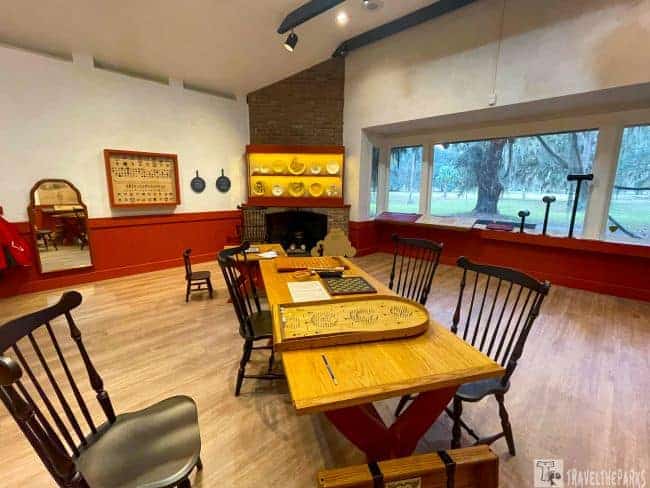
Discover Astonishing History in the Interactive Exhibits
Visitors will learn about the site’s history and explore the fort and town through interactive displays and hands-on activities. In one room, you can play quintessential 18th-Century games or try dress costumes as a colonial lady or soldier. To avoid boredom, the park provides a little scavenger hunt and a Junior Ranger activity book for kids. Don’t forget your passport stamps while in the Visitor’s Center. They are located beside the front ranger information desk.
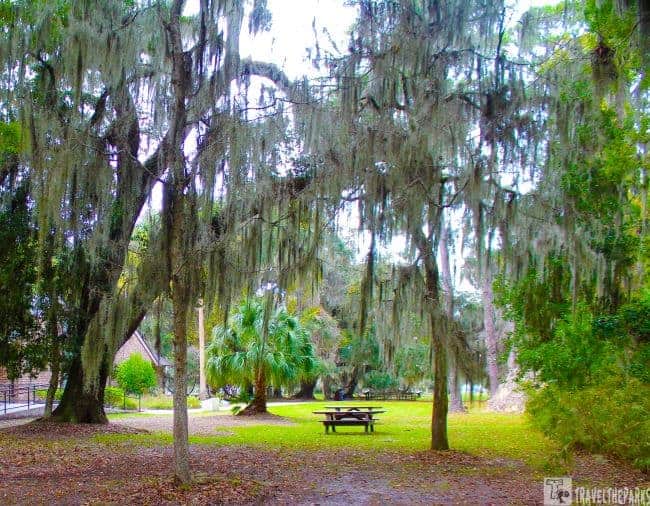
The National Park Service does offer ranger guided tours and educational programs that provide more information about the fort’s history and the people who lived and worked there. We learned much about the strategic importance of the fort and Oglethorpe’s role in the fort’s defensive capabilities and the daily life of the soldiers.
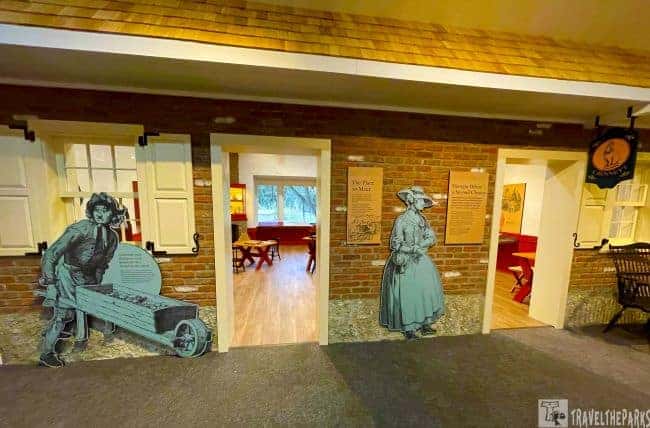
Note: Dogs must be leashed by 6 feet and waste must be collected. Fort Frederica National Monument provides dog waste bag stations and water fountains for dogs at the visitor center/historic area entrance.
Annually, the Fort Frederica Festival takes place on the second Saturday in February. In celebration of Frederica Town’s founding and settlement in 1736, this is the park’s most prevalent event. The museum offers many activities, including living history demonstrations, archeological exhibits, and period music. The highlight is “A Taste of Frederica” where a local chef serves up traditional Frederica cuisine.
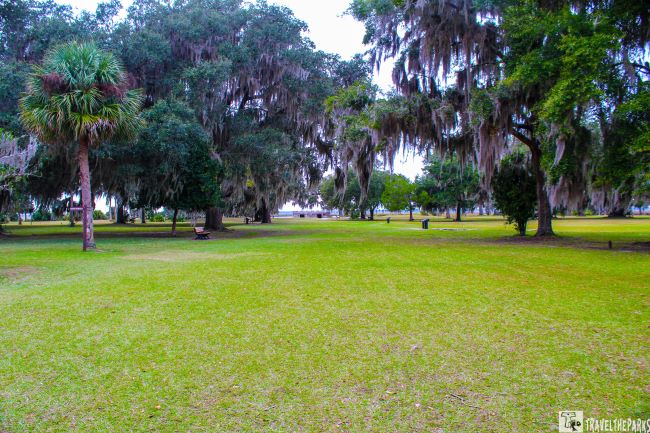
The Inspiration for Esteemed Fort Frederica
A 20-year period of hostilities ensued between the Spanish and British over lands between South Carolina and Florida. George II, in 1732, granted lands to a group of trustees to settle the lands. Chief among them was General James Oglethorpe. The idea was to take those less desirable, mostly the poor, and allow them to create a utopia in the new world. The promised land was open to those kept in debtor’s prison. Many arriving by boat, first settling in the newly founded town called Savannah.
General James Oglethorpe was looking to expand fortifications. Oglethorpe discovered the ideal spot at the mouth of the Altamaha River on St. Simon Island. He set about establishing Fort Frederica on a high bluff overlooking the river, protecting Darien and Savannah from the expansion of the Spanish armada.
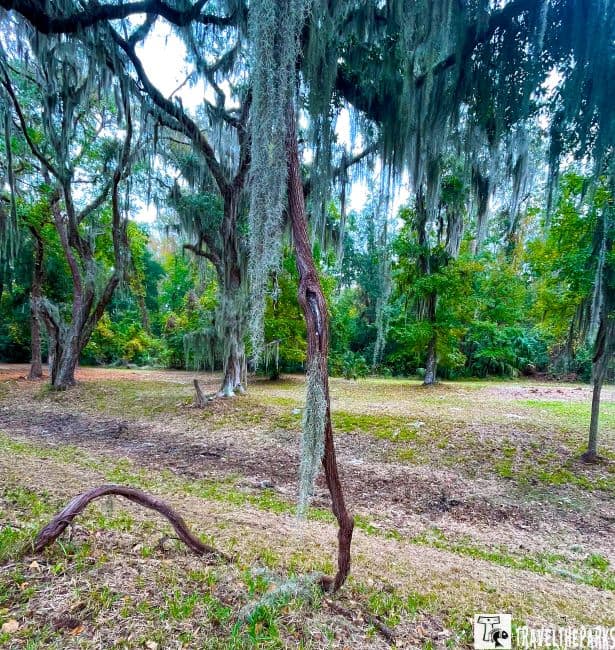
He named the town in honor of Frederick Louis, Prince of Wales, the only son of King George II. The first settlers at Frederica were 44 men and 72 women and children in 1736. In 1740, this number reached 1,000.
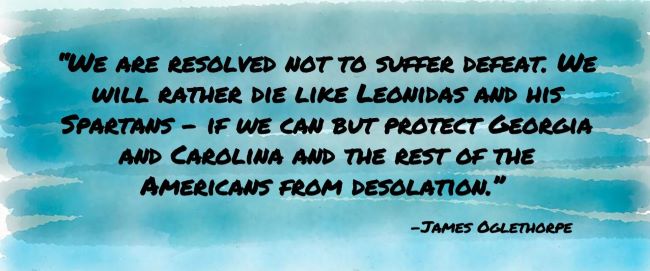
On weekends Fort Frederica National Monument truly comes to life, when period actors and living history volunteers perform musket firings, demonstrate making a dugout canoe, and burn lime ricks to create tabby, Join one of Oglethorpe’s soldier’s dressed in historically accurate clothing from the 42nd Regiment of Foot, learning about the day-to-day troop routines.
Note: Sadly, the harsh living conditions led to one-third of the freeholders of Frederica, leaving within the first 5-years.
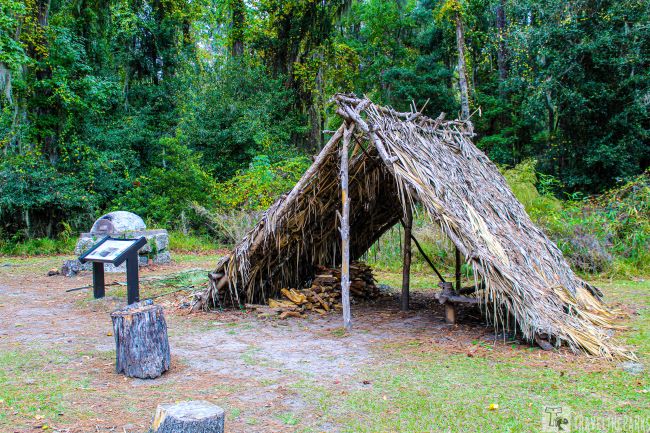
A Precious History at Fort Frederica National Monument?
Each family received 60- by 90-foot lots. Additionally, they received 50 acres of land to clear for cultivating crops. They constructed primitive makeshift camps during the early settlement phases using palmetto bushes. They reconstructed the replica huts on the grounds today from drawings documented by Philip George Friedrich Von Reck. The 25-year-old visited Fort Frederica in 1736. Standing and looking at the replica, I can’t imagine what it must have been like in the summer heat. The biting insects must have been unbearable.
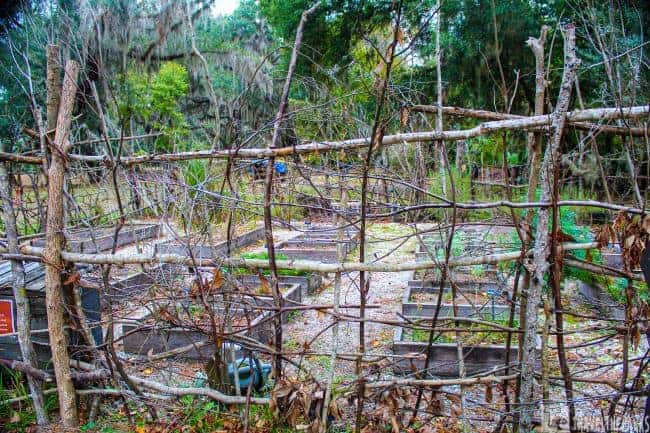
In later years, they built more permanent dwellings. The most common building materials used were tabby and wood by most of the townsfolk. Richer families could include imported bricks and glass windows in constructions.
Note: “Oglethorpe tabby” is an interesting mixture made from oyster shells burned to make lime. The lime combined with sand, ash, broken oyster shells and water forms a concrete-like mixture. During the colonization of Frederica, settlers constructed lime ricks as part of the process to make tabby for construction.
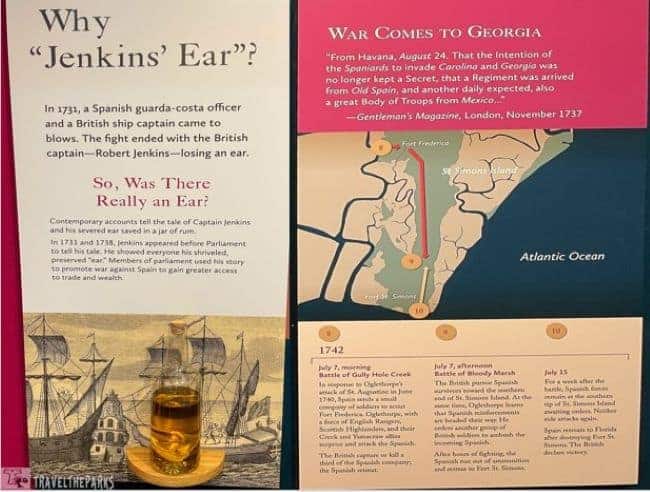
The War of Jenkins’ Ear
The hostilities between the Spanish and British over the lands between South Carolina and Florida lasted 20 years. Six years after Georgia’s founding, the conflict reached a head in 1739.
As part of the War of Jenkins’ Ear, the Battle of Bloody Marsh was fought on July 7, 1742. The dispute involved lands and shipping. It all began when Captain Jenkins, a privateer from the British Isles, lost his ear after the Spanish, punished him for raiding their ships in 1731. In outrage, he marched to parliament asking for retribution. After diplomatic efforts failed, they declared war in 1739. The growing animosity eventually led to the bloody Marsh, part of a larger conflict referred to as the War of Jenkins’ Ear.
An invasion of Georgia by the Spaniard Dan Manuel de Mantiazo with 4600 soldiers occurred during the War of Jenkins’ Ear. After the defeat in St. Augustine, General James Oglethorpe successfully held off the invasion with less than 1000 supporters.

Stop #1-Town Gate & Military Road
It is easy to understand how early settlers protected themselves by studying the fortifications, moat, and barracks. Earthen works were first constructed, beginning with a quadrangular rampart, anchored by 4 bastions. Two actively guarded gates protected the residents. The town gate at the Military road guarded the land side of the fort (Stop #1). A portion of the military road that linked Frederica with Fort St. Simons, and on which the Battle of Bloody Marsh took place, can still be seen today. They used the riverside gate for shipping/trading traffic.

Orange trees originally lined broad street, planted by the first residents. It is the principal thoroughfare and divides the town into north and south sections. Broad street ran the entire length of the fort from the front gate to the fort powder magazine on the bluff overlooking the river. The colony design used an arrangement of streets at right angles creates a grid pattern. This ensured that all lots had a uniform size.
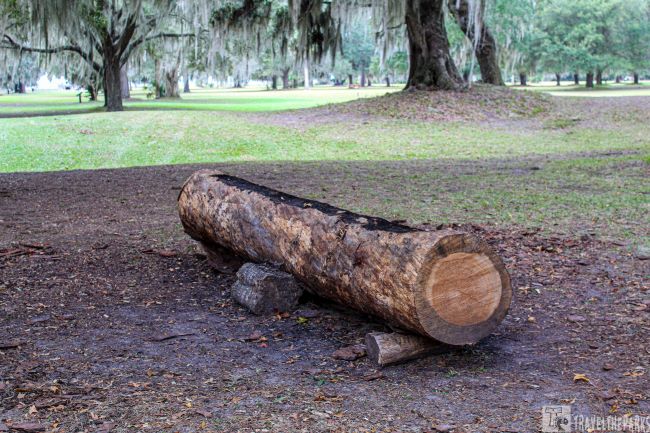
Many of the townspeople were skilled or trades workers. They grew their own crops and hunted the surrounding marsh, as game was abundant. The town in 1740 would have appeared as if it were a small northern English village. Settlers traded harmoniously with the local indigenous peoples, the Yuchi, Yarnacraw and Creek. They banded slavery in the village.
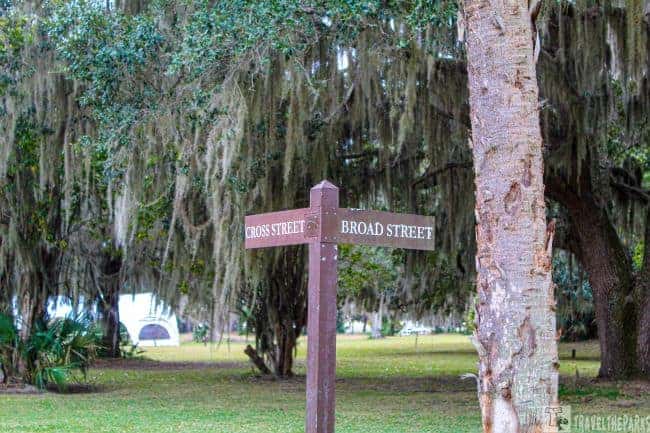
Self-Guided Walking Tour Loop Along Broad Street
Today, this 40-acre property is a beautiful location on a bluff overlooking the Frederica River. Fort Frederica has an underlying sense of serenity and tranquility that draws you in. The open grounds are well-manicured. Massive live oaks draped in Spanish moss hem in the 84 lots. None of the original orange trees survived. I thought about what this town was like during colonial times. I closed my eyes, imagining how the town must have sounded, looked, and smelled when it was fully occupied.

We enjoyed wandering across the grounds under the live oaks and the Spanish moss. Beginning from the wooden boardwalk, we walked Broad Street first. While Fort Frederica has lost most of the original settlement buildings from 1736 to time, archeologists have excavated many of the foundations. There are placards at every stop that provide historical information. Archaeological artifacts discovered during excavations filled many of the display cases. It added a layer of authenticity to the stories with the ability to see specific artifacts left behind by the residents whom lived here.

Stop #2-Cherished Indigenous Interpreter-Mary Musgrove (Lot 10-South)
The first foundation on the left is the home of the Indian Interpreter, Mary Musgrove Matthews. Her house was constructed using tabby materials. She was a skilled interpreter, negotiator and trader held in high esteem by the townsfolks. Mary Musgrove served as a skilled interpreter and mediator between the English colonists and the Creek and Yamacraw tribes of Native Americans.
Highly regarded Mary Musgrove as the daughter of an English trader and a Creek Indian mother. She was fluent in both English and Creek and was an important liaison between the two cultures. She helped to negotiate treaties, land purchases and other agreements between the colonists and the Native indigenous tribes.
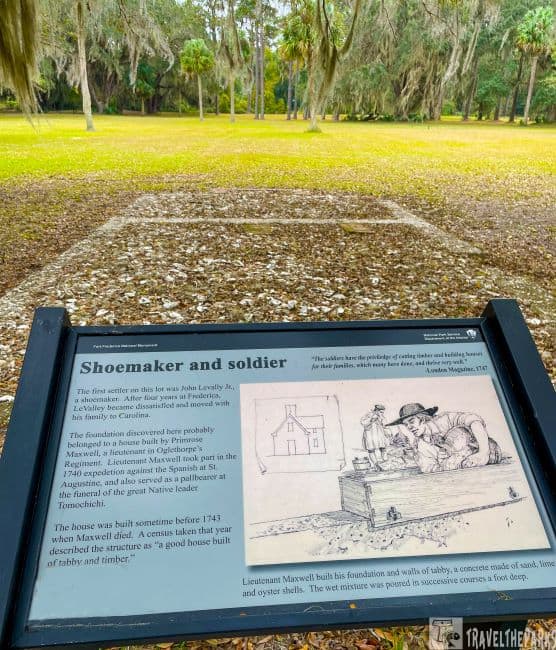
Stop #3- Levally-Maxwell Homesite (Lot 9 South)
Walking Broad Street, the first home lot belonged a freeholder named John Levally Jr, also a shoemaker. He was disenfranchised by the people of Fort Frederica. Archeologists discovered shoemaking tools and scissors in the excavation in the 1950s.He left after only four short years. Lieutenant Primrose Maxwell, a soldier loyal to Oglethorpe, built this home where this foundation remains.
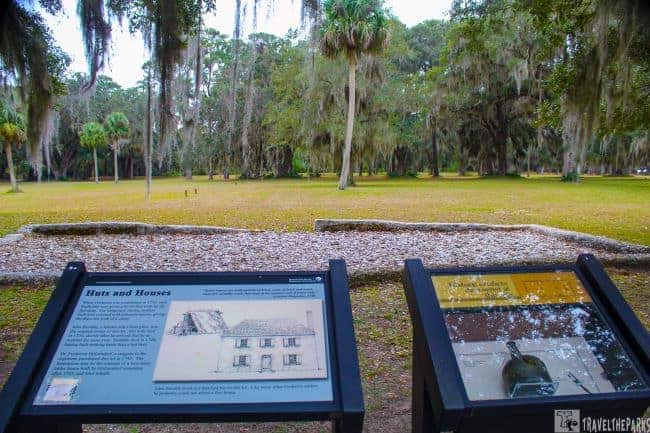
Stop #4-Humble-Holzendorff (Lot 8 South)
John Humble, the boat pilot, originally settled the next lot in 1736,. His elderly wife died during the transatlantic voyage to the new world. He remarried his wife Catherine at Fort Frederica. He died in 1940 before establishing a permeant residence. Dr Fredrick Holzendorff, a doctor, purchased the lot in 1743, building a two-story tabby house.
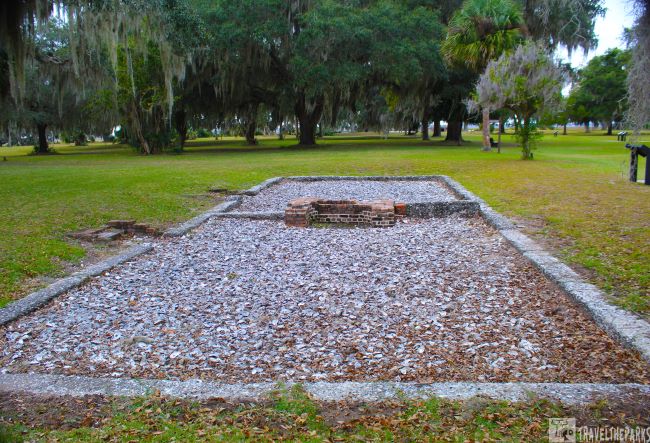
Stop #5-Allen House (Lot 6 South)
Originally the home of Will Allen, the town baker. Archeologists discovered the home had two wine cellars. Allen left after a dispute with Hawkins. The home foundation here shows fire destroyed it, possibly the great fire of 1758. The home was built by Captain James MacKay.
Captain James MacKay was a commanding officer under General James Oglethorpe during the early years of the colony of Georgia. He was a member of Oglethorpe’s regiment, the 42nd Foot, and arrived with him in Georgia in 1733. He served in the military campaigns against the Spanish and the local indigenous tribes, and also took part in the building and defense of Fort Frederica.
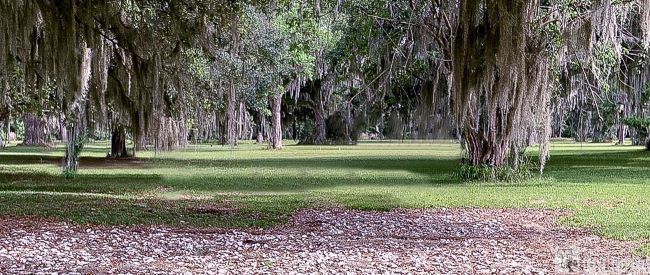
Stop #6 -Priscilla and Patrick Houstoun’s House (Lot 4 South)
Patrick Houstoun was an 18th-century British lawyer and politician who served as the President of the Council of Georgia and as the Chief Justice of the Superior Court of the Province of Georgia. He was a significant figure in the early history of Georgia and was one of the leading figures in the colony’s establishment of Georgia as a state.
Houstoun came to Georgia in 1735 as a member of the Trustees for Establishing the Colony of Georgia. They appointed Patrick Houstoun as the President of the Council of Georgia and served as the colony’s chief executive officer. He was one leader of the colony during the time of the construction of Fort Frederica and was present during the Battle of Bloody Marsh. He played an active role in the colony’s establishment and in its administration, and was considered a popular leader among the colonists.
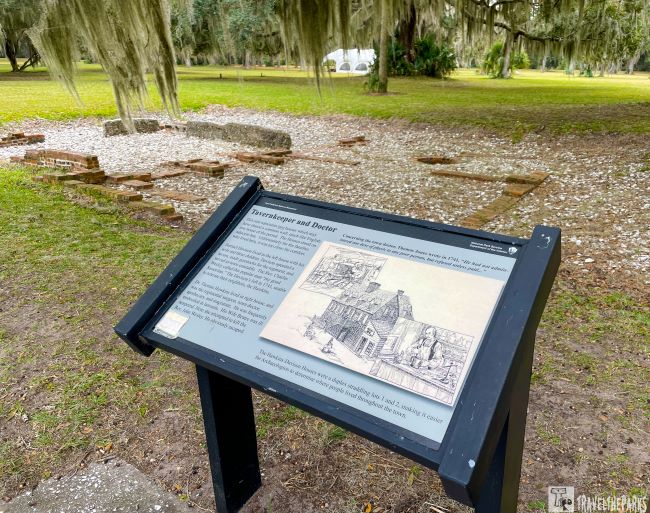
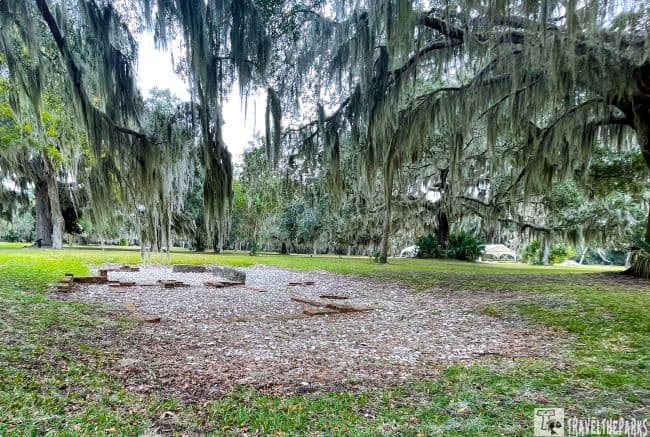
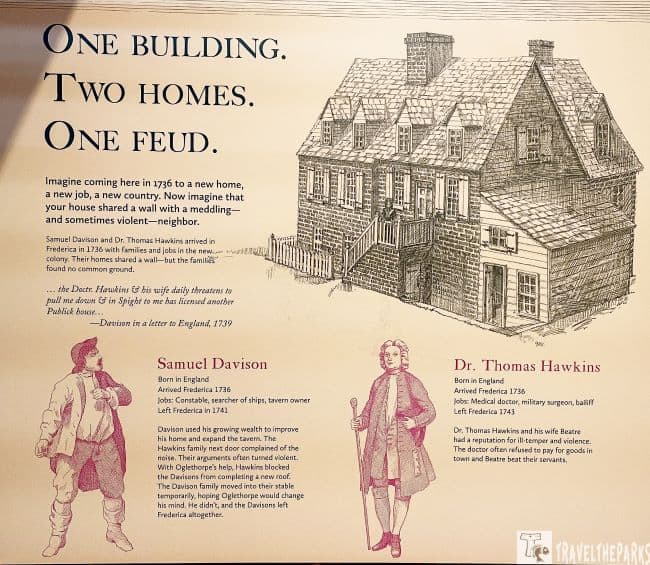
Stop #6 The Disputed Hawkins-Davison Feud
Samuel Davison ran the local tavern from the three-story brick duplex that shared a common wall. Spread over two lots, the Davison family lived on the left side of the home with his wife Susanna and a young daughter and two sons. Dr. Thomas Hawkins’ family occupied the right side. Hawkins was the regiment’s doctor, Frederica’s bailiff, and ran a small apothecary shop from his home. Married to his wife Beatre, she was renown for her short fuse. At one point, she attempted to kill Rev. Charles Wesley. s. The duo was infamous for their feud that often spilled over into the community. Dr Hawkins became known as a troublemaker as he disagreed with many residents of the community, including neighbors Calwell and Perkins. Oglethorpe often intervened during these disputes. Eventually, Davison, tired of the domestic conflict, left Frederica with his family and moved to Charleston, South Carolina, in 1741.
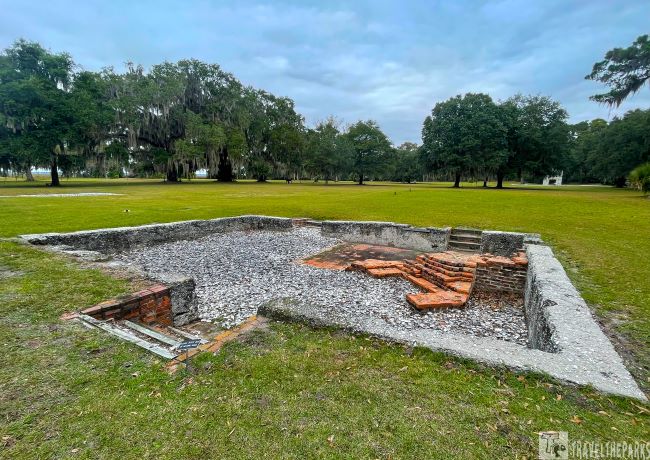
Stop #7-Prosperous the Calwell House (Lot 4 North) & Perkins House (Lot 2 North)
There was no better dwelling in town than the three-story Calwell house. Here, John Calwell made candles and soap, and his wife ran a shop. They constructed their home using tabby. The foundation ruins show the remains of the bake ovens and two fireplaces used in the making of candles and soap. They exported the products to Pennsylvania and New York. In addition, he served as the “Conservator of the Peace,” a bailiff, surveyor, and shopkeeper.
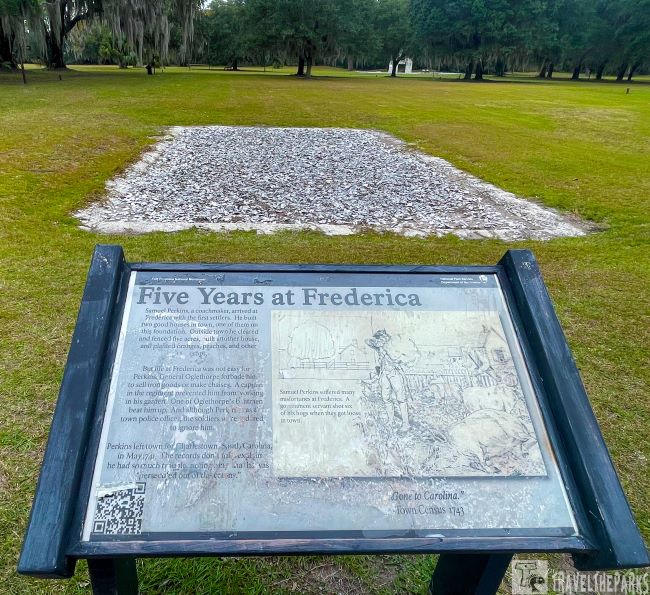
Samuel Perkins was a coachmaker. He built two homes within the walls of Frederica. The townsfolks, specifically James Oglethorpe, made life difficult for Samuel. Persecuted he could not sell his goods, even preventing him from working his garden. In 1741, he left for Charlestown, SC.
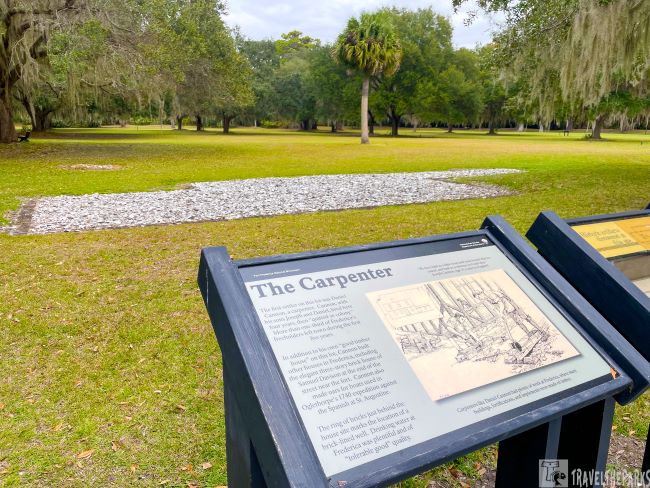
Stop #8-Daniel Cannon Carpenter house (Lot 6 North) & Wilson House (Lot 7 North)
The town carpenter Daniel Cannon settled here with his sons Joseph and Daniel JR. Although he only lasted 4 years in the village, he built many of the timber frame homes. He worked tirelessly on fortifications and many of the household goods needed. James MacKay later claimed this lot.
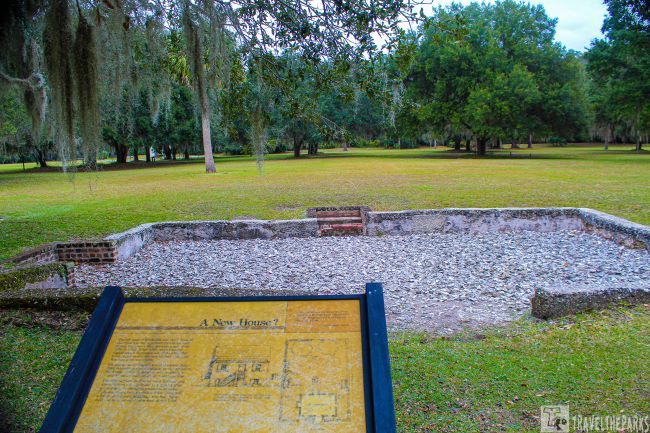
Atkey Wilson and Michael Wilson were the first settlers and owners of the lot. They returned to England after seven years (1743). In fact, James Spalding probably built the foundation of this house in 1768. Upheame Campbell, a soldier and tailor, was given a 21-year lease on the property by the Wilsons.
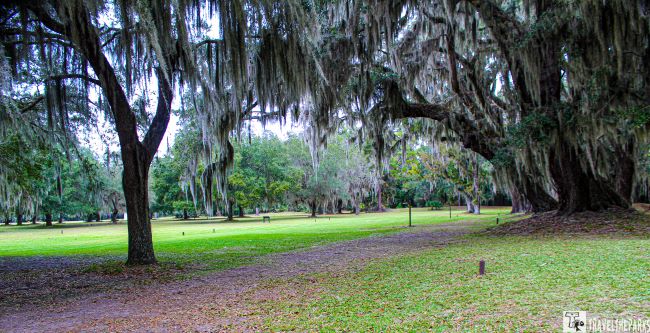
Houstoun left the colony in 1737 because of personal and political issues, but his legacy and contributions to the colony of Georgia and Fort Frederica are still remembered. He is one of the key figures in the early years of the colony, and his name is still associated with the history of Fort Frederica and the colony of Georgia.
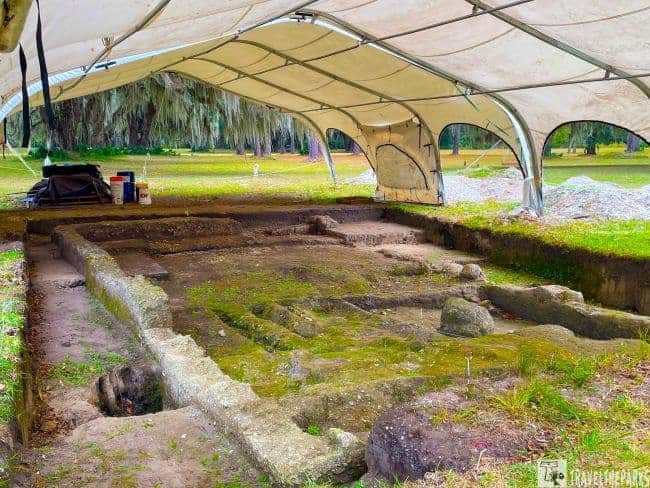
There is currently an one active archaeological excavation. It is believed to be Colonial-era resident Archibald Sinclair, owner of Lot 34 South. He was an innkeeper after leaving servitude in the Houstoun house. Historians think he was a long-lived resident of Fort Frederica as there is no record of him and his wife returning to Britain.
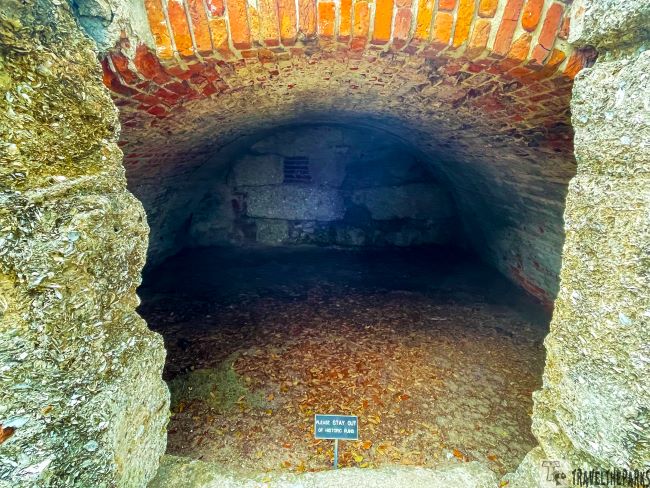
Stop #10-The Kings Magazine & Storehouses
They built the citadel at the end of Broad Street, sitting on a raised bluff. Surrounded on either flank by the marshlands. All that remains today is the powder magazines. A square structure with diamond bastions. The fort was built on the west side of the town. An artist’s rendition shows how the fort would have been protected by a wooden palisade and earthen fortifications.

King’s Magazine at Fort Frederica was a military magazine or storage building for ammunition and supplies, erected in 1736-1737. It was one of several tabby structures built to support the defense of the colony and was a key part of the fortifications at Fort Frederica. Built partially underground to protect the supplies from enemy fire and to keep munitions cool and dry, it is all that remains of the original defense structure. The magazine played a role in the events leading up to and during the Battle of Bloody Marsh, which took place nearby in 1742. Today, the site of Fort Frederica is a National Monument and the location of the King’s Magazine is marked by a historical marker.
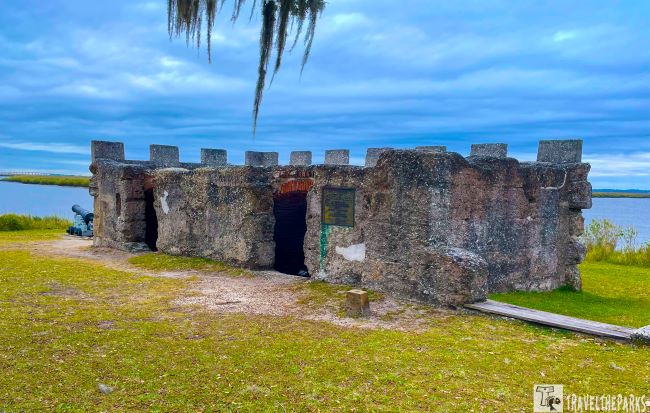
The North and South storehouse foundations, the blacksmith shop, and a few remaining cannons. A crew of six was required to fire the cannons. The King’s magazine had three cannon tubes. In the fort’s parapet, cannons were mounted behind embrasures. The carriages of the guns rolled on wooden platforms. These cannons would have protected the wharf and the shipping channel. Originally, cannons lined a spur that jutted out into the channel. The spur has vanished because of erosion by the river. It is thought that the initial 15 cannons were removed from the fort by 1762.
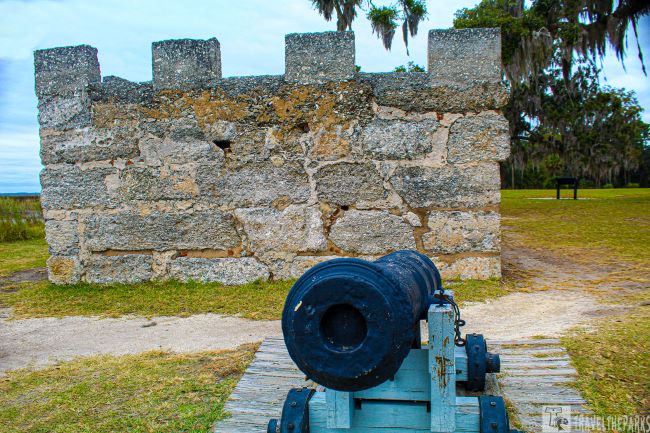
The Storehouses
Among other vital supplies, the soldiers stationed at the fort stored food, tools, and equipment in the storehouses. They were near the center of the citadel, behind the King’s magazine. Strategically placed to be easily accessible to the troops in case of an attack. Archeologists determined the storehouses to be of timber-frame and brick. They sometimes used it as a church or a courthouse when necessary. The placard showed that Frederica’s food stores for 1737 included about 20,586 pounds of meat, 15,980 pounds of rice, and over 8,000 gallons of wine.

Stop #11-Blacksmith Shop
Blacksmiths were essential tradespeople who created and repaired a wide range of metal objects, including tools, weapons, household items, and horseshoes. They worked in small shops using forge, anvil, and hammers to shape iron and steel.

Grounds Trail of Prized Fort Frederica National Monument
Some may think that because, mostly, the foundations of the fort remain, it is not worth the time. I disagree, wandering the grounds and the nature trail just for the tranquility and the magnificent views is worth an hour or two.
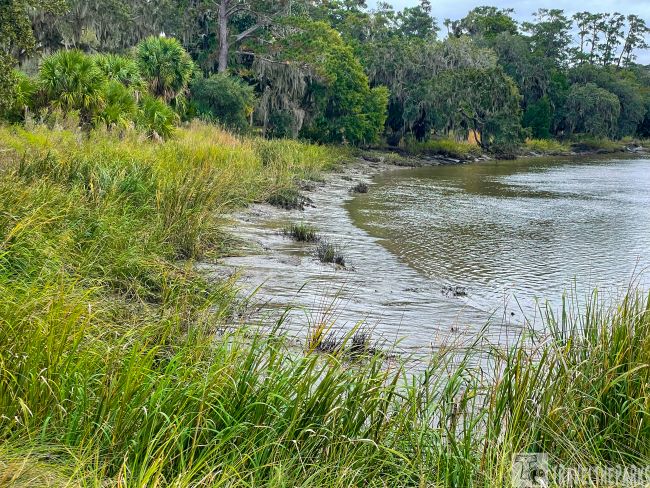
Stop #11-Francis Moore-Keeper of the Kings Stores
Francis Moore was the Oglethorpe’s secretary, town recorder and keeper of the king’s storehouses. Apparently Oglethorpe frequently disagreed with Moore’s handling of the fort affairs. Moore and his wife lived in a modest, small two-story brick house that archaeological evidence shows burned to the ground (Lot 41-north). Archaeologists excavated it in 1958. Moore published an eyewitness account of the founding of Frederica entitled A Voyage to Georgia.
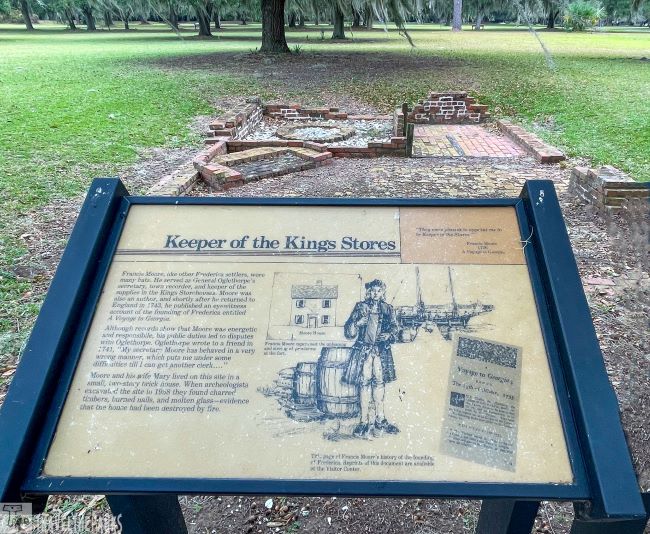
Francis Moore was an 18th-century British physician and author who served as a surgeon at the fort of Frederica, on St. Simons Island, Georgia. He was present at the Battle of Bloody Marsh and wrote an account of the battle and his experiences in the colony. In 1744, he published a book titled “A Voyage to Georgia” which describes the founding of the colony of Georgia, the native peoples, natural resources, and the political climate.
This book serves as a primary source for understanding the early history of Georgia and the interactions between British colonists and Native Americans. He also describes various medical treatments he used while in Fort Frederica, providing insight into the medical practices of the time.
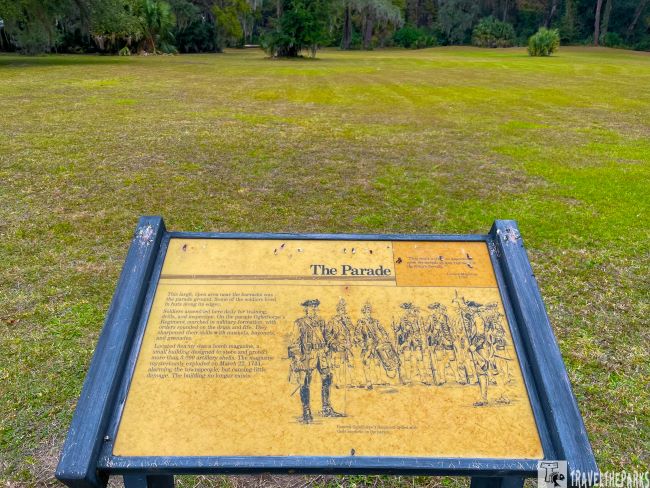
Stop #12-The Parade Ground
The parade grounds are a 120 by 400 foot open grassy space within the fort where soldiers would assemble and drill. Daily, they held military exercises, parades, and inspections. The parade grounds were a central component of the fort and played an important role in the defense and organization of the colony. Skills practiced included weapons such as muskets, bayonets, and swords. Oglethorpe’s fife and drum corps singled the march and military formations.
There used to be over 3,000 artillery shells stored and protected in the bomb magazine, a small building near the parade grounds. On March 22, 1744, the magazine suddenly exploded. The incident did not result in any casualties. Currently, there are no remnants of the building at this location.
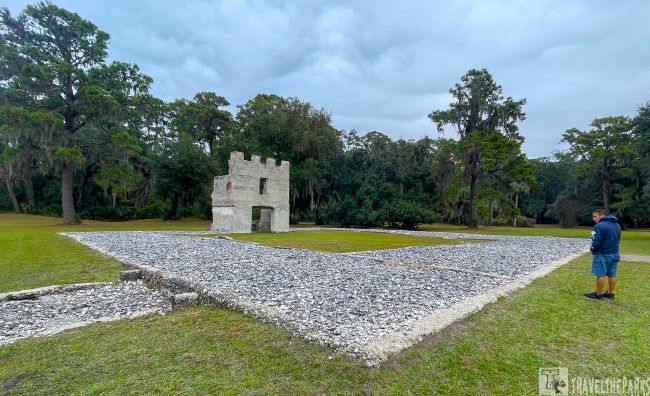
Stop #13-The Barracks
After the fort was abandoned, it is likely that the barracks were dismantled or fell into disrepair. Built in the 18th century, the barracks at Fort Frederica were the living quarters for the military officers and soldiers stationed at the fort. The two-story square building was made of wood and tabby, with multiple rooms for soldiers to sleep and store their belongings. The barracks are near the fort’s western wall to provide easy access for soldiers in case of an attack. It also held the military hospital and quarters for Spanish prisoners of war. All that remains today on the grounds is the entry tower.
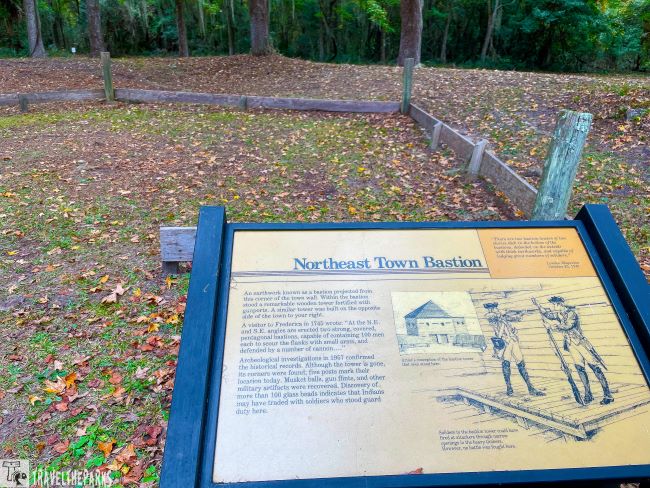
Stop #14-Northeast Bastion
A bastion is a defensive structure that projects out from the main walls of a fort, allowing the defenders to fire at attackers from multiple angles. The Northeast Bastion has been successfully preserved as part of the original fortifications.
In 1739, Oglethorpe built the northeast bastion to protect his land against Spanish invasion. Fortifying the town included earthen ramparts and moats that were 6 to 8 feet deep, as well as cedar palisades that were 10 feet high. A minimum of 100 soldiers defended it, armed with muskets, positioned to deter attacks from the north and east.

Stop #15-Tombs in the “Burying Ground”
John and Charles Wesley presided over the funerals here. Many of the early settlers lie within the burial ground tombs. The walled burial ground contains four raised burial tombs and a large brick and tabby vault. Located to the right of the visitor’s center. There is a short trail to James E. Oglethorpe’s home site marker.
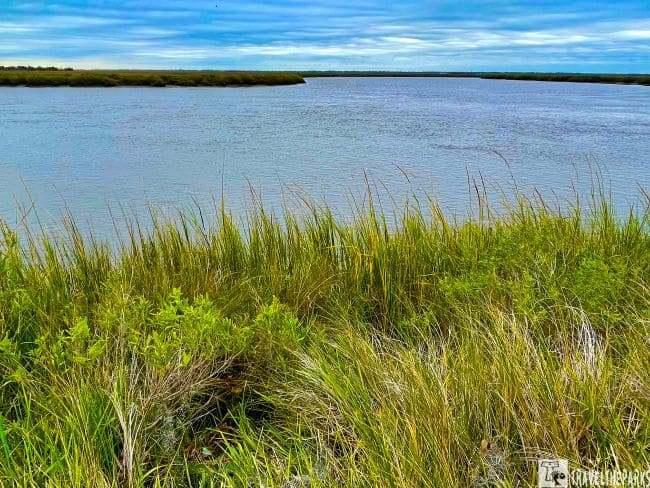
Fort Frederica’s Nature Trail-Treasured Fort Frederica National Monument
Fort Frederica not only preserves the historical ruins, it also protects 250 acres of coastal barrier island habitat. The Fort Frederica’s nature trail maneuvers through the maritime forest that surrounds most of the monument. The looping trail is 2-miles beginning at the fort. We turned left, following the Frederica River. The numbered markers are in order. Sixteen number markers highlight the different species of flora and fauna.
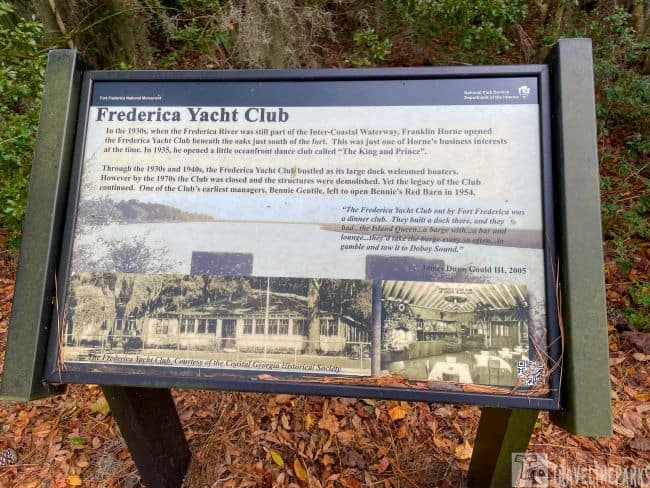
Frederica Yacht Club
The dingy dock is where the trail turns back into the forest. We learned that in the 1930s, the Frederica Yacht club was a popular venue. Frank Horne opened the club, calling it the “Kings and Prince.” It flourished with boats from the inter-coastal waterway through the 30s and 40s before a downturn. Sadly, it closed in the 1970s and was demolished. The land was later annexed and became part of the Fort Frederica National Monument, managed by the National Park Service.
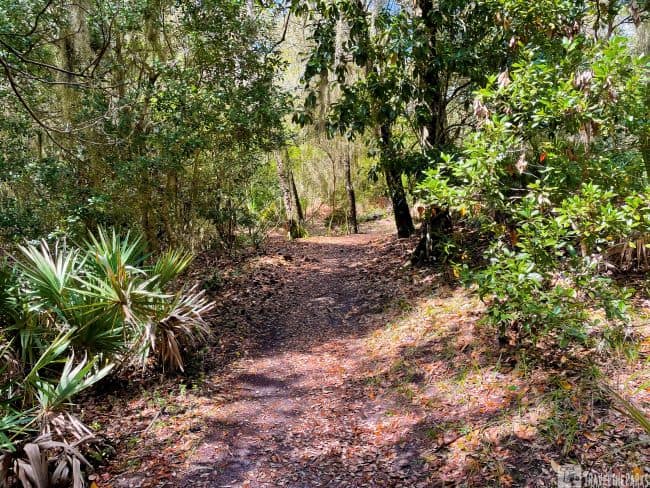
In the park, visitors can enjoy historical tours, dog walks, and other recreational activities. It’s a great place for birdwatching, walking, picnicking, fishing, and kayaking. If you plan to spend the day, pack plenty of water, snacks, sunscreen, bug spray, sunglasses, and remember your camera.
Note: Sandspurs were abundant and pose a hazard to pets.
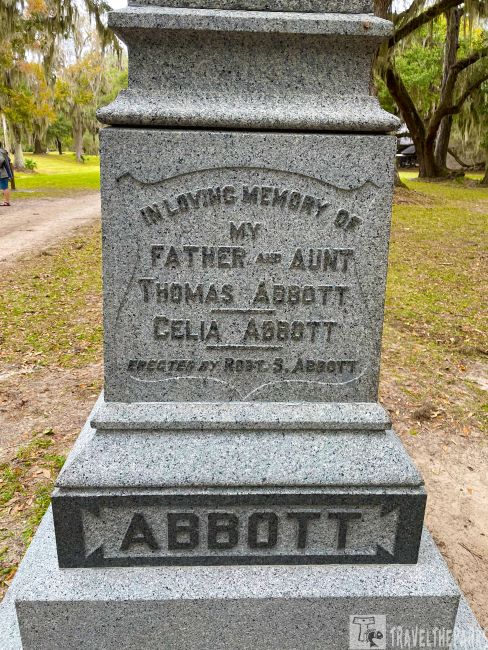
African American Burial Ground-Treasured Fort Frederica National Monument
A small cemetery with African American burial plots is on the eastern side of the Fort. A memorial dedicated to Thomas Abbott and his aunt, Celia Abbott, stands here as well. St. Simons Island native and Chicago Defender founder Robert Abbott paid for the construction and installation of the monument. Dedicated in memory of his father In Savannah, the Oglethorpe Marble and Granite Company constructed the Abbott Monument at a cost of $1600. Despite not having a precise date, they installed the monument in January 1929.
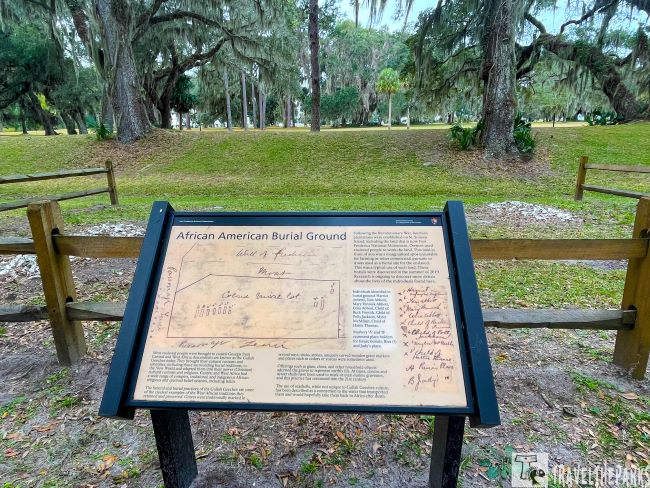
A Prized Victory at The Battle of Bloody Marsh
Bloody Marsh Battle Site is a detached park unit located 5-miles south of the Fort on Demere Road. It memorializes the battle between British and Spanish forces in 1742. The Battle of Bloody Marsh was a military engagement that took place on July 7, 1742, near the present-day city of St. Simons Island, Georgia. It was here that Spanish forces made the northernmost advance in North America.
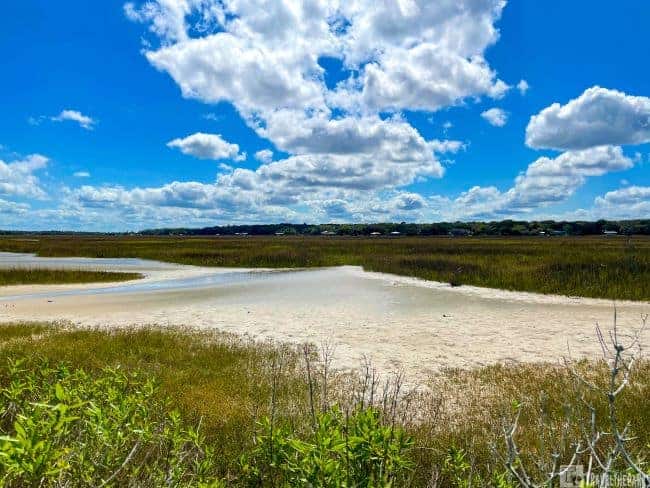
Governor James Oglethorpe led a British force against Captain Don Manuel de Montiano’s Spanish force. There was a larger conflict between Britain and Spain, known as Jenkins’ Ear, which had begun in 1739, that led to the battle. On St. Simons Island, the Spanish landed a force in preparation for an assault on the nearby British fort of Frederica. Spanish forces advanced on the fort, unaware that the British had been warned of their plans; they were ambushed by the British. As a result of being caught off guard, the Spanish suffered heavy casualties, while the British suffered only minor losses.
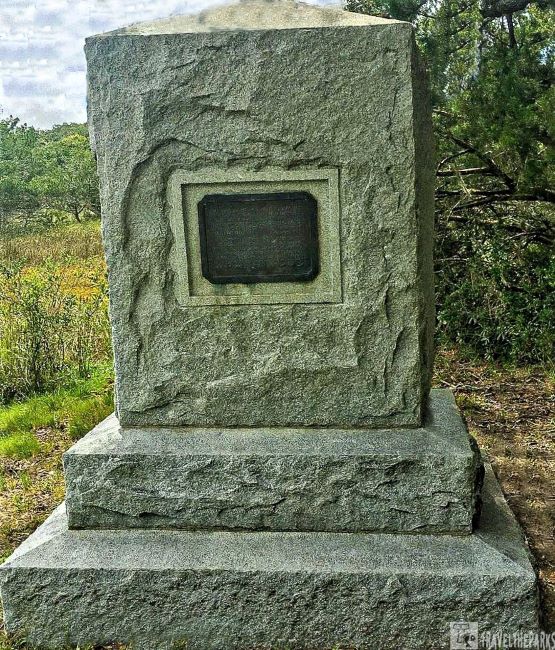
The Surrender of the Spanish-Final Treaty
For the British, it was a decisive victory. Spanish attempts to invade Georgia ended with the Battle of Bloody Marsh, solidifying British control. In 1848, Spain and the Britain signed a peace treaty that eventually led to the abandonment of Fort Frederica.
TIP: Don’t forget to bring your bug spray! For maximum protection, use it in combination with permethrin-treated clothing.
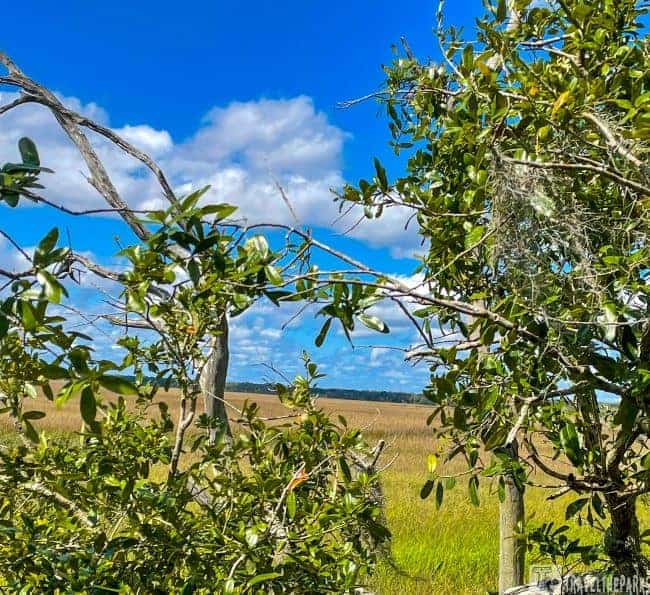
Because of Oglethorpe’s actions and effective tactics, he regained his role as a military leader. A disgruntled employee made 19 claims of fraud and cowardice against him years later, leading to a court martial. He leaves Georgia to return to Britain where he sets up a successful business, marries and dies at 89. Not long after, Georgia officially became a state.

Final Thoughts on Why No One Talks about Treasured Fort Frederica National Monument
We have visited many forts around the US and Canada. Fort Malden, Fort Clinch, Fort Pickens and Fort Pulaski all have distinct features and characteristics. Consider traveling a few miles south to visit the Tybee Island Light Station, Castillo de San Marcos and Fort Matanzas in St. Augustine, FL.

Somehow, this was a unique experience, with only the ruins of the fort remaining. You had to use your imagination to visualize what the small town would have looked like. Despite our plans to make this a brief stop during our Georgia camping trip, this place blew us away. We felt like we were taking a step back into another time. Overall, Fort Frederica is well worth the visit. It’s a veritable treasure.
Have you been to Fort Frederica National Monument? Do you want to go? What did you think of it? What is your favorite historic site in the US?


